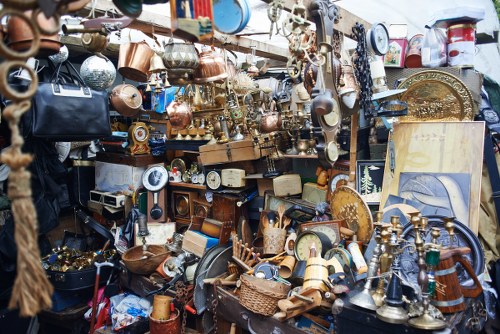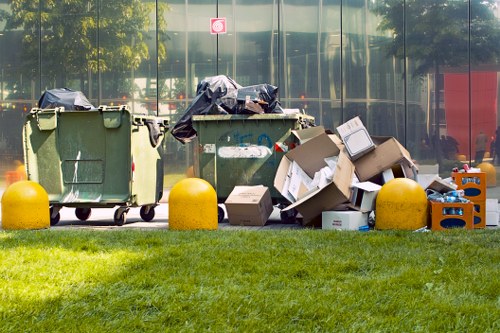Efficient Bed Disposal in Office Clearance: A Comprehensive Guide

Office clearances often involve the removal of various types of furniture, including beds used for employee rest areas or temporary accommodations. Proper bed disposal is crucial not only for maintaining a clutter-free workspace but also for adhering to environmental and regulatory standards.
Understanding the best practices for bed disposal ensures that businesses can manage their office clearances smoothly and responsibly. This guide delves into the essential steps and considerations for effective bed disposal in office settings.
Whether upgrading office facilities, relocating, or downsizing, knowing how to dispose of beds properly can save time, reduce costs, and minimize environmental impact.
Why Proper Bed Disposal Matters

Proper bed disposal is more than just a matter of cleanliness; it plays a significant role in sustainability and compliance with local regulations.
Improper disposal can lead to environmental harm, fines, and a negative impact on a company’s reputation. On the other hand, responsible disposal practices contribute to a greener planet and demonstrate a company’s commitment to social responsibility.
Moreover, organized bed disposal can streamline the office clearance process, making it more efficient and less disruptive to daily operations.
Environmental Impact

Beds are typically made of wood, metal, and other materials that can have a substantial environmental footprint if not disposed of correctly. By recycling or donating usable parts, businesses can significantly reduce waste and conserve resources.
Recycling materials like metal frames and wooden components helps in reducing the need for virgin resources, thus lowering the carbon footprint associated with manufacturing new products.
Additionally, proper disposal methods ensure that harmful chemicals or materials are not released into the environment, safeguarding ecosystems and public health.
Steps for Effective Bed Disposal

Implementing a structured approach to bed disposal can simplify the process and ensure all aspects are covered.
Here are the key steps to follow:
- Assessment: Evaluate the condition of the beds and determine whether they can be reused, recycled, or need to be discarded.
- Planning: Develop a disposal plan that includes timelines, methods, and responsible parties.
- Execution: Carry out the disposal process following the planned steps, ensuring compliance with regulations.
- Documentation: Keep records of the disposal process for accountability and future reference.
Assessment Phase
Begin by inspecting each bed to decide its fate. Beds in good condition might be suitable for donation or resale, while damaged ones may require recycling or proper disposal.
Consider factors such as the material composition, age, and overall functionality. This assessment helps in making informed decisions that align with your office’s sustainability goals.
Engaging professionals during this phase can provide insights into the most effective disposal methods based on the specific types of beds you have.
Planning the Disposal Process
Once the assessment is complete, create a detailed plan outlining how each bed will be handled.
Include information on timelines, transportation logistics, and the parties responsible for each step of the process.
Having a clear plan ensures that the disposal process is organized, efficient, and minimizes disruption to the office environment.
Executing the Disposal Plan
With a solid plan in place, proceed to execute the disposal steps methodically.
Coordinate with disposal services, recycling centers, or charitable organizations as needed.
Ensure that all actions comply with local regulations and industry standards to avoid potential legal issues.
Choosing the Right Disposal Method

Selecting the appropriate disposal method is essential for effective bed disposal in office clearance.
Different methods cater to various needs, whether it’s recycling, donating, or discarding. Here are the primary disposal options:
- Recycling: Breaking down beds into recyclable materials like metal and wood.
- Donation: Donating beds in good condition to charities, non-profits, or individuals in need.
- Resale: Selling used beds through online marketplaces or second-hand stores.
- Professional Disposal Services: Hiring specialized companies that handle large-scale disposals efficiently.
Recycling Beds
Recycling is an eco-friendly disposal method that ensures materials are repurposed rather than ending up in landfills.
Companies can collaborate with recycling centers that handle specific materials, ensuring each component of the bed is processed appropriately.
Recycling not only reduces waste but also supports the circular economy by turning old materials into new products.
Donating Usable Beds
If the beds are still in usable condition, donating them is a sustainable option.
Charities, shelters, and non-profit organizations often need furniture donations to support their operations and assist those in need.
Donating beds can also provide tax benefits for businesses, making it a win-win situation.
Reselling Used Beds
Reselling beds is another viable option, especially if they are in good condition.
Online platforms like eBay, Craigslist, or specialized furniture resale websites can facilitate the sale of used beds, helping businesses recoup some of their costs.
Reselling promotes reuse, extending the lifespan of office furniture and reducing demand for new products.
Professional Disposal Services
For large-scale or complex bed disposals, professional services can offer comprehensive solutions.
These companies handle everything from transportation to proper disposal, ensuring compliance with all regulations.
Outsourcing disposal tasks allows businesses to focus on their core activities while experts manage the clearance process.
Cost Considerations
Effective bed disposal requires careful budgeting to manage costs without compromising on quality.
Several factors influence the overall cost, including the disposal method, the number of beds, and the need for additional services like transportation or processing.
Understanding these cost elements helps businesses make informed decisions that balance financial constraints with disposal needs.
Budgeting for Disposal
Start by estimating the total number of beds and the preferred disposal methods. Recycling might incur lower costs compared to professional services, which offer more comprehensive handling but at a higher price.
Consider potential savings from donating or reselling beds, which can offset some of the disposal expenses.
Additionally, factor in any hidden costs such as labor, transportation, and potential fines for non-compliance.
Maximizing Cost Efficiency
To keep disposal costs manageable, explore multiple disposal avenues and choose the most cost-effective options.
Combining recycling with donation can minimize waste and reduce expenses, while also contributing to social responsibility.
Negotiating contracts with disposal service providers can also lead to better rates and tailored solutions that fit your budget.
Potential Financial Benefits
Proper bed disposal can lead to financial benefits beyond cost savings.
Donating usable beds can provide tax deductions, while reselling can generate additional income.
Moreover, efficient disposal practices reduce the risk of fines and penalties, protecting the company’s financial health.
Compliance and Regulations
Adhering to local and national regulations is essential when disposing of office furniture, including beds.
Non-compliance can result in significant fines and legal issues, making it imperative to understand and follow the relevant laws.
Staying informed about regulatory requirements ensures that the bed disposal process is both legal and ethical.
Understanding Local Laws
Disposal regulations can vary widely depending on the location. It’s important to familiarize yourself with local waste management laws, recycling mandates, and disposal guidelines.
Some regions have specific rules regarding the disposal of certain materials commonly found in beds, such as metal frames or wooden components.
Consulting with legal experts or regulatory bodies can provide clarity and ensure compliance.
Environmental Regulations
Environmental laws govern how waste and recyclable materials should be handled.
Compliance with these laws ensures that the disposal process does not harm the environment and aligns with sustainability goals.
Non-compliance can lead to severe penalties, so it’s crucial to follow environmentally responsible disposal practices.
Record-Keeping and Documentation
Maintaining accurate records of the bed disposal process is a key compliance requirement.
Documentation should include details such as the number of beds disposed of, the methods used, and the entities involved in the disposal.
Proper records provide accountability and can be essential in the event of audits or regulatory reviews.
Hiring Professional Services
While DIY disposal is possible, hiring professional services can offer numerous advantages.
Professional disposal companies bring expertise, efficiency, and comprehensive solutions to the bed disposal process.
They handle everything from logistics to compliance, ensuring a hassle-free clearance experience.
Benefits of Professional Disposal
Professional disposal services offer streamlined processes, reducing the time and effort required from your team.
They have the necessary equipment and expertise to handle large or complex disposals, ensuring that beds are disposed of correctly and safely.
Moreover, these services often provide environmentally friendly disposal options, aligning with corporate sustainability goals.
Choosing the Right Service Provider
Selecting a reputable disposal company is crucial for successful bed disposal in office clearance.
Consider factors such as experience, certifications, and the range of services offered.
Reading reviews and asking for references can help in identifying reliable providers who meet your specific needs.
Cost vs. Value
While professional services may come at a higher cost, the value they provide in terms of efficiency, compliance, and peace of mind can outweigh the expenses.
Evaluate the total benefits, including reduced risk of non-compliance and time saved, when deciding to hire professional help.
Investing in quality disposal services can lead to long-term savings and a smoother office clearance process.
Recycling and Sustainability
Recycling plays a pivotal role in sustainable bed disposal, turning waste into valuable resources.
Adopting recycling practices as part of your office clearance efforts demonstrates a commitment to environmental stewardship.
Here’s how to incorporate recycling into your bed disposal strategy:
Identifying Recyclable Materials
Beds are composed of various materials, each requiring different recycling processes.
Common recyclable components include metal frames, wooden parts, and certain types of fabrics.
Separating these materials facilitates efficient recycling and ensures that each component is processed correctly.
Partnering with Recycling Centers
Collaborate with local recycling centers that specialize in handling the materials found in beds.
These centers have the expertise and facilities to break down and repurpose materials effectively.
Building a relationship with recycling partners can streamline the disposal process and enhance overall sustainability efforts.
Benefits of Recycling
Recycling reduces the demand for new raw materials, conserving natural resources and lowering environmental impact.
It also minimizes waste, preventing materials from ending up in landfills and reducing greenhouse gas emissions.
By integrating recycling into bed disposal, businesses contribute to a circular economy and promote environmental responsibility.
Donation and Community Support
Donating usable beds fosters community support and extends the lifespan of office furniture.
It provides valuable resources to organizations and individuals who may benefit from them, enhancing the social impact of your office clearance.
Here’s how to effectively incorporate donations into your bed disposal plan:
Selecting Beneficiaries
Identify reputable charities, shelters, or non-profits that can utilize the donated beds.
Ensure that the recipients can accept and properly use the beds, maintaining the quality and integrity of the donations.
Communicate with potential beneficiaries to understand their specific needs and requirements.
Logistics of Donation
Organize the transportation and delivery of donated beds to the chosen beneficiaries.
Coordinate with the receiving organizations to schedule drop-offs and ensure a smooth handover process.
Providing clear instructions and support during the donation process helps build strong relationships with community partners.
Maximizing Impact
To maximize the impact of your donations, maintain the beds in good condition and ensure they are functional and safe for use.
Regularly communicate with beneficiaries to receive feedback and understand how the donations are benefiting them.
Sharing the positive outcomes of your donations can enhance your company’s reputation and encourage future charitable efforts.
Handling Unsalvageable Beds
Not all beds are suitable for recycling or donation. Handling unsalvageable beds responsibly is essential to minimize environmental harm.
Here are the steps to manage beds that cannot be reused:
- Disassembly: Break down the bed into its constituent parts to facilitate easier disposal.
- Waste Management: Dispose of non-recyclable materials following local waste management guidelines.
- Hazardous Material Handling: Manage any hazardous components, such as treated wood or certain metals, in accordance with safety regulations.
Disassembling Beds
Properly disassembling beds is crucial for efficient disposal. It allows for the separation of recyclable and non-recyclable materials.
Use appropriate tools and safety gear during the disassembly process to ensure safety and prevent damage to materials.
Document the disassembly process to maintain transparency and accountability.
Managing Non-Recyclable Waste
Identify materials that cannot be recycled and dispose of them through approved waste management channels.
Coordinate with local waste disposal services to handle these materials, ensuring they are processed in an environmentally responsible manner.
Avoiding illegal dumping or improper disposal helps uphold environmental standards and regulatory compliance.
Handling Hazardous Components
Some beds may contain hazardous materials that require special handling, such as treated wood, coated metals, or certain adhesives.
Follow specific guidelines for the disposal of these materials to prevent environmental contamination.
Engage with professionals who specialize in hazardous waste management to ensure safe and compliant disposal.
Case Studies: Successful Bed Disposal in Office Clearance
Examining real-world examples can provide valuable insights into effective bed disposal strategies.
Here are a couple of case studies showcasing successful bed disposal in office clearance scenarios:
Case Study 1: Tech Startup Relocation
A rapidly growing tech startup needed to relocate its office space, requiring the disposal of numerous beds used in employee rest areas.
The company opted to recycle 70% of the beds, partnering with a local recycling center to process metal frames and wooden components.
The remaining beds in good condition were donated to a nearby shelter, earning the company tax deductions and positive community recognition.
Outcome
The relocation process was streamlined, with minimal disruption to daily operations. The company saved on disposal costs and enhanced its corporate social responsibility profile.
Case Study 2: Corporate Downsizing
A large corporation undergoing downsizing needed to clear out office furniture, including several beds.
They hired a professional disposal service that handled the entire process, from assessment to transportation and recycling.
By choosing professional services, the corporation ensured compliance with all regulations and achieved a clutter-free workspace efficiently.
Outcome
The company successfully downsized without incurring fines or environmental penalties. The professional service provided detailed documentation, simplifying the compliance process.
Conclusion
Bed disposal in office clearance is a multifaceted process that requires careful planning, adherence to regulations, and a commitment to sustainability.
By following best practices and considering all disposal options, businesses can manage their office clearances efficiently and responsibly.
Implementing structured disposal strategies not only benefits the environment but also enhances a company’s operational efficiency and social responsibility.
Take Action Today
Don’t let the challenges of bed disposal hinder your office clearance plans. Contact us today to learn how our professional services can simplify your bed disposal process and ensure a smooth, compliant, and eco-friendly clearance.
Book Your Service Now
Ready to streamline your office clearance? Book your service now and take the first step towards a clutter-free and sustainable workspace.